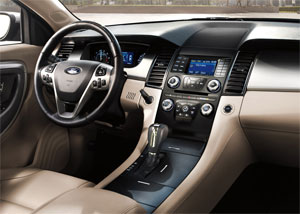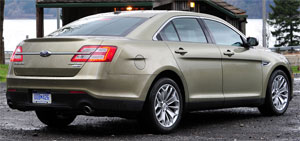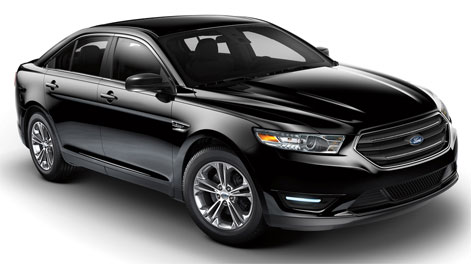2013 Ford Taurus
While big sedans no longer drive big sales numbers for automakers, there are still a sizeable group of buyers who enjoy them. Spend any time in a Taurus, Charger, or Impala and you’ll see why: they deliver an abundance of comfort, room, and power at a reasonable price. The Ford Taurus indeed has all of that covered, and for 2013 it’s looking to bring something else to the segment… fuel economy. Let’s see how big the gains are.
The big news for Ford’s biggest car offering is actually small news, well smaller anyway; and it’s not exactly new either. Okay, enough of the runaround. What we’re trying to say is that Ford’s 2.0-liter EcoBoost I4 engine is now available in the 2013 Ford Taurus.
But, that’s not the only news as this mid-cycle re-fresh also begins with the typical redo of front and rear fascias, but it doesn’t end there. The hood gets a more muscular shape, taking design cues from the high-performance SHO model, wheels are wider to fill up the wheel wells better, and rear quarter panels get reshaped to house larger full-LED tail lights. It’s a big improvement on what was already a strikingly sleek design for a big sedan, and it still looks great.
 The interior also looks good, but maybe not as grand as Ford likes to think. Fit and finish is first-rate and materials have been upgraded, but our SEL equipped tester’s black-on-black theme made for a very dark environment. It’s also not as roomy up front as you might expect from such a big car, but the layout is practical and there are plenty of small-item storage nooks. Both the back seat and trunk are huge however, the latter holding 20.1 cubic-ft. of goods.
The interior also looks good, but maybe not as grand as Ford likes to think. Fit and finish is first-rate and materials have been upgraded, but our SEL equipped tester’s black-on-black theme made for a very dark environment. It’s also not as roomy up front as you might expect from such a big car, but the layout is practical and there are plenty of small-item storage nooks. Both the back seat and trunk are huge however, the latter holding 20.1 cubic-ft. of goods.
And there’s no lack of tech. to go around with features like SYNC and MYFord Touch. This is the latest gen. of MyFord Touch and its operation is improved, but the bottom row of buttons are still hard to see and access, and some of the touch screen controls are small and hard to hit precisely with while driving. Fortunately there are plenty of redundant controls on the steering wheel as well as voice command; so driver distraction can be reduced.
And, it was driving this Taurus where the new EcoBoost I4-turbo really piqued our interest. Here output rates 240-horsepower and 270 lb-ft. of torque, mated to a 6-speed automatic transmission that sends power to the front wheels only. You have to go with the standard V6 if you want to add all-wheel-drive.
So, it’s off to the track we go to see what type of motivation the 2.0 provides. Well, with a healthy growl and a nice hit of power, you can hit 60 in 8.0-seconds. Those numbers aren’t super impressive, but the car doesn’t feel underpowered at any time, especially not when you stay around 35-hundred RPM where the power delivery is extra-thick. The quarter mile took 16.2-seconds at a speed of 87 miles-per-hour. Through the cones, you won’t exactly forget it’s a big car, but the Taurus does wear its weight well. It feels very sporty, with a nice hefty wheel that gives surprisingly good feedback. Body roll is minimal. Brakes are very sporty as well, with a nice firm pedal, bringing our eco-2-point-0 to a halt in just 126-feet.
Now, it’s doubtful that many Taurii spend too much time on the track, so thankfully it feels great on the street as well. We drive so many small cars these days that driving one this big feels old-school and sort of comforting.
Government Fuel Economy Ratings are the true reasoning behind adding the 2.0-liter EcoBoost to the Taurus and they are impressive for a big sedan; 22-City, 32-Highway, and 26-Combined. We averaged a good 27.8 miles-per-gallon of Regular in mixed driving. And that makes for a slightly better than average Energy Impact Score of 12.7-barrels of oil burned annually with CO2 emissions of 5.7-tons.
 And, while it may be more economical to operate on the back end, it will require a little extra investment up front, as the 2.0-liter EcoBoost will add $995 to any front-wheel-drive SE, SEL, or Limited Taurus.
And, while it may be more economical to operate on the back end, it will require a little extra investment up front, as the 2.0-liter EcoBoost will add $995 to any front-wheel-drive SE, SEL, or Limited Taurus.
Smaller engines in big cars is certainly the wave of the future, as there are still plenty of people who need a full-size car to haul 5 full-sized adults, but would like to do so more efficiently. Well, the 2013 Ford Taurus has indeed gotten more efficient, but there are also enough new tweaks to help keep it in its proper place as the standard bearer of full-size American passenger cars.
Specifications
- Engine: 2.0-liter EcoBoost I4
- Horsepower: 240
- Torque: 270 lb-ft.
- 0-60 mph: 8.0 seconds
- 1/4 mile: 16.2 seconds @ 87 mph
- EPA: 22 mpg city/ 32 mpg highway
- Energy Impact: 12.7 barrels of oil/yr
- CO2 Emissions: 5.7 tons/yr
2024 Polestar 2
More Range And More Power For The Polestar 2
Volvo is well on their way to making the transition to an all-electric brand, but their sister-brand Polestar is already there. Now, we’ve spent lots of time in their all-wheel drive, five-door Polestar 2, having tested it in 2021, and a year later when a two-wheel drive version arrived. But, EV updates are coming quickly. So, let us be your guide for all that’s new with the Polestar 2.
While we are driving more EVs than ever, we’ve also been spending a lot of time recently circling back to ones we’ve previously tested. As in this new era of electrified vehicles, significant updates are arriving quickly, with R&D investments increasing and retrofitting them easier than ever. This is often done through software updates that can even be accomplished over the air. For 2024, the Polestar 2 has indeed gotten some software updates, but some physical ones as well.
Clearly aimed directly at Tesla’s Model 3 when it arrived; the Polestar 2’s build quality was vastly better, but range definitely came up short. So, addressing that was priority No. 1; and for ’24 the Polestar can travel up to 20% farther than before while consuming 9% less energy, and when it comes time to charge it back up, it can do that 34% faster too.
Range in the Single Motor version increases from a max of 270 to 320 miles thanks to a larger 82-kWh battery pack, and that solitary motor now powers the rear wheels, not the front wheels. It’s also bigger, coming in at 220 kW compared to the previous 170 kW front-wheel drive version, going from 231 to 299 horsepower.
Dual Motors keep the same 78-kWh battery, but still sees a boost from 260 to 276 miles and takes advantage of the larger rear motor for a new combined 310-kW output with 421 horsepower. Our test car has the added Performance Pack, which uses an additional 35 kW to deliver 455 horsepower and 546 lb-ft of torque, though max range drops to just 247 miles.
The new battery in rear-drive 2s will also charge faster, now accepting up to 205 kW for an 80% charge in 20 minutes; max for dual-motors stays at 155 kW, which puts an 80% charge at 34 minutes. Using 32 kWh of electricity per 100 miles, the Dual Motor earns a good efficiency rating.
The [Polestar] 2 has always been one of the most enjoyable EVs to drive, even more so now with that additional power coming from the rear motor.
Unfortunately, extremely cold temperatures kept us from seeing that increased range, as we were only on pace for about 194 miles in our test.
The 2 has always been one of the most enjoyable EVs to drive, even more so now with that additional power coming from the rear motor. And especially when equipped with the Performance Pack as it not only includes more power, but adds 20-inch forged wheels, upgraded brakes, and adjustable Ohlins Dual Flow Valve performance dampers. It greatly improves handling prowess without affecting ride quality, and is easily worth the $5,500 charge if you at all enjoy driving.
Even on a 20-degree track day there was plenty of grip through our handling course. No understeer or oversteer, and lots of feedback through the wheel. There was a nice, strong launch off the line that properly planted us firmly in the seat, and rocketed us to 60 in 4.5 seconds. Power delivery stayed pretty intense up until about 80 mph when there was a definite tapering off. Still, it was a 13.4-second quarter-mile at 102 mph; smooth, quiet, and stable the whole way.
When this car debuted, its Google-based infotainment setup was a novelty, but since then, more and more manufacturers are just “Googling it” so it doesn’t seem out of place at all. The wireless phone charger is easy to access, and there’s a great Harmon/Kardon sound system and panoramic sunroof to enhance the in-cabin experience. Exteriors have also been enhanced with a smooth grille insert and new wheel choices.
Hatchback practicality means 14.3 cu-ft of easy to access cargo space with split-folding seatbacks for longer items and expanding the space to 38.7 cu-ft. Plus, there’s even a sizeable storage bin up front under the hood.
Single Motor Polestar 2 pricing now starts at $51,300, with Dual Motors starting at $56,700; topping out at $64,400.
For a car manufacturer that hasn’t even been around for a decade yet, Polestar has kept itself busy, totally transforming their latest model in just a few years, making the 2024 Polestar 2 even more appealing. They are certainly off to a good start, and with a host of Polestars just over the horizon, including some all-important utility vehicles, this star will be shining even brighter.
Specifications
As Tested
- Motor Setup: Dual Motor
- Horsepower: 455
- 0-60 mph: 4.5 seconds
- EPA Range: 247 miles
- Efficiency : 32 kWh / 100 miles
- Battery Size: 78-kWh
- Torque: 546 lb-ft
- 1/4 Mile: 13.4 seconds at 102 mph
- MW Test Loop: ~ 194 miles
- Peak Charging Rate: 155 kW











































